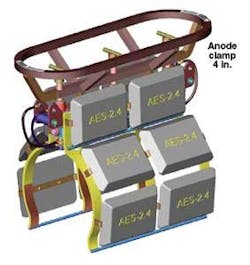Innovation enhances deepwater flexible pipe life
Judimar Clevelario, Helio Marins
Marcio Albuquerque, Wellstream International Ltd.
As flexible pipe applications move into deepwater and ultra deepwater, attention is focused on enhancing service life, particularly with respect to corrosion and wearing. In Brazil’s offshore Campos basin, Petrobras and Wellstream International Ltd. have addressed both issues for unbounded dynamic flexible risers and static flowlines.
The first means of enhancing service life is the use of a latch sleeve insert to address damage in flexible risers caused by friction between the outer polymer sheath of the riser and the I-tube at the vessel hang-off. The second is the use of anode clamps to protect flexible pipe endfittings against corrosion.
Petrobras’ original I-tube latch sleeve had a metallic “trumpet” that interfaces directly with the bend stiffener within the I-tube for a metal-polymer contact between the flexible riser outer sheath and the latch sleeve.
This metal-polymer contact, when subjected to cyclic bending, tension, friction, and pressure loads from the FPU’s dynamic response, resulted in excessive wear and abrasion damage of the riser polymeric outer sheath. In some cases, the outer sheath was damaged to the point that the outer tensile wires were exposed to the marine environment and subject to failure from corrosion and metal-metal contact. Furthermore, Petrobras found that outer sheath wear damage was critical on FPSO installations. Damage came from axial displacement of the riser inside the I-tube causing outer sheath (polymer) friction against the internal surface of the latch sleeve (metallic).
Wellstream developed a new latch sleeve design to eliminate excessive wear of the riser outer sheath material within the contact region. The sleeve was designed for a 20-year dynamic service life in a typical Campos basin application.
The latch sleeve mechanism has an internal replaceable insert made of similar materials to those used in typical bend stiffener moldings. The polymer-polymer contact is similar to that between the riser outer sheath and the bend stiffener. The new latch sleeve still has a trumpet design for a smooth transition of the flexible riser within the contact region.
The design was based on the following:
- In-service survey data
- Petrobras’ requirements
- Bend stiffener supplier design and field experience
- Full-scale dynamic fatigue tests and subsequent detailed dissection.
The most cost-effective solution was a split polymeric replaceable insert made with the same polyurethane material as the bending stiffener, assembled on the internal diameter of the latch sleeve adapter. The polymeric insert prevents direct metal-polymer contact, which is the major cause of wear.
In developing the design, the design team analyzed concerns such as design performance, assembly, installation, and maintenance. Upon completion, the design was submitted to the customer, and following approval, was installed on the Marlim and Marlim Sul fields. The latch sleeves were scheduled for installation on all Wellstream flexible pipes using the I-tube latch sleeve mechanism on Petrobras’ FPSOs.
The design team developed a non-linear finite element model that reproduces the contact among the bend stiffener, latch sleeve, and riser to confirm qualitatively that the compression load magnitude at the contact surface of the pipe outer sheath and inner bending stiffener has the same magnitude as the pipe outer sheath and inner latch sleeve insert.
Analysis results confirmed that the contact pressure between the pipe outer sheath and inner bending stiffener, and pipe outer sheath and inner latch sleeve insert have the same magnitude. The team concluded that using the same bending stiffener material should avoid excessive wearing damage.
It is important to guarantee that wearing occurs in the polymer insert before it does in the outer sheath. An abrasion test results-graph of high and medium performance polyurethane (in accordance with DIN 53516) shows that medium-performance polyurethane is more susceptible to wear than high-performance polyurethane, nylon (PA-11), or HDPE - all typical riser outer sheath materials. Therefore, medium-performance polyurethanes were used in the new latch sleeve.
Anode clamp
The second area addressed by the design team was corrosion. Offshore equipment is subject to severe corrosion. Although equipment often is manufactured of special materials to prevent or minimize corrosion, cathodic protection still can be required.
Petrobras expressed concern about ancillaries on several installed flexible pipe. One of the most critical ancillaries is the endfitting, a metallic device that connects the flexible pipe to a pipeline end termination (PLET) or a pipeline end manifold (PLEM).
The starting point of the project was the development of cathodic protection that did not require removal of the endfitting. Removal would increase the installation cost and possibly halt production.
Wellstream developed a metallic structure with clamps that can be installed by an ROV without removing the endfitting or stopping production.
The result was an anode clamp consisting of a metallic structure with clamps and clamp grooves for surface cleaning to guarantee a contact between clamp surface and surface to be protected, with aluminum anodes attached.
In June 2003, the first anode clamp was installed on the subsea endfitting abandoned on Barracuda field, near RJS-458, in 800 m (2.625 ft) water depth. In May 2004, Petrobras requested a new anode clamp design for installation on an endfitting near the RO-09 well on the Roncador field in 1,800 m (5,905 ft) water depth. The second anode clamp was installed in August 2004.
A major concern during the anode clamp design was guaranteeing electrical contact between the clamp and the endfitting. Primarily, the electrical contact is made through the clutches. Internal grooves were designed to aid the surface cleaning and to enhance contact capability. Additionally, contact pins on the equipment were designed to give extra contact between the anode clamp and endfitting.
Another issue was to make installation easy. The design team created a clamp that could be installed by an ROV; no special vessel is required. Furthermore, production need not stop during installation. Before the actual clamp placement, an ROV cleans the endfitting surface with a steel brush for better electrical contact. Then, the anode is set over the fitting and clamped into place. Then, the contact pin is set.
Wellstream carried out testing that led to the conclusion that the system could be used on flexible pipes. Inquiries revealed that all of the materials required were available locally.
To confirm the function of the anode, the electrical potential of the endfitting was measured before and after the clamp was installed. The measure indicated the cathodic protection was in place.
Acknowledgement
The authors thank Petrobras S.A. for contributions to both projects.




